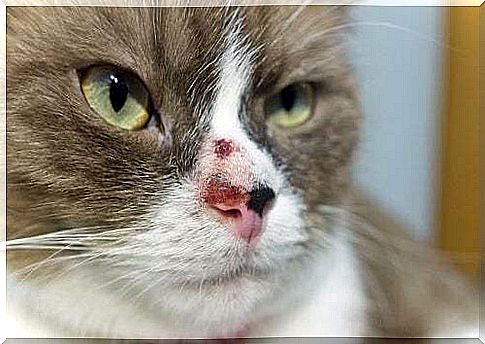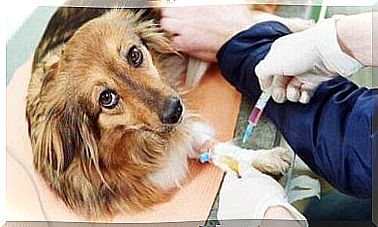Skin Cancer In Cats: Causes And Treatment

Cancer is an abnormal proliferation of cells that can invade all types of tissues and organs such as the skin. Squamous cell carcinoma is the most common skin cancer in cats.
Normally, it appears in the ears, nose, muzzle and eyelids, in short, on the less protected areas of the skin, but tumors inside the mouth are also frequent. Tumors are more common in older and white cats and are often caused by sun exposure.
The main causes
In the vast majority of cancer cases, the exact cause is unknown. However, there are certain factors that can influence the onset of cancer, such as:
- Genetics. There are cat breeds with a greater genetic predisposition to suffer from cancer than others. This discourse is also valid on an individual level.
- Diet. The type of feeding is a factor that greatly influences the health of the animals. Some foods prevent cancer due to their physicochemical properties. Other foods, however, are associated with other types of cancer.
- Environmental factors. Pollution, tobacco smoke, sun exposure… Skin cancer in cats is associated with continuous exposure to the sun. Like us humans, excessive sun exposure can cause skin lesions and cancer, especially in the most exposed areas.
How is skin cancer diagnosed in cats?
Squamous cell carcinoma in cats presents with pink lesions, areas of alopecia and scabs on the skin that may initially be confused with other skin diseases or wounds. As the disease worsens, the skin acquires a more reddened appearance and ulcerated areas with a harder surface may appear, such as in the case of scabs.

The ears, nose, muzzle and mouth are the most affected areas. As the cancer spreads rapidly destroying surrounding tissue, it can invade other areas of the body such as the inside of the oral cavity and the lungs.
As always, the expert’s diagnosis is crucial for the treatment of the disease. If you notice these lesions, go to the vet right away to confirm or reject a cancer diagnosis. To confirm that it is a tumor, an examination and a biopsy will be necessary, that is, to take a sample of tissue, of the most affected areas.
The most advanced and precise radiography, as well as computed tomography, are diagnostic tools that look for cancerous masses and study their evolution. They are very useful when these masses are found within the oral cavity, which frequently occurs with skin cancer in cats.
Skin cancer treatment in cats
The success of the treatment depends a lot on the severity of the disease. If the lesions are very minor, they can be treated and even prevented by avoiding exposure during the hottest hours or by applying a high protection factor cream to the most vulnerable areas, although in the case of cats, this task will probably not be easy. .

If the lesions are severe and it is a squamous cell tumor, the possible treatments are:
- Surgical removal of the tumor. The earlier this technique is performed, the better, as it will prevent the tumor from progressing to healthy areas of the skin. To do this, all cancerous tissue and a margin of healthy tissue around it will need to be removed to prevent the disease from returning. If only the ears are affected, as is often the case, removal may be the best solution.
- Radiotherapy. Radiation therapy can be used in conjunction with the aforementioned method to ensure complete elimination of all traces of cancer. This technique is generally more expensive and is only practiced in specialized veterinary centers.
- Chemotherapy. Pharmacological treatment reduces cancerous masses: the vet will determine the duration of the sessions for it to be successful.









